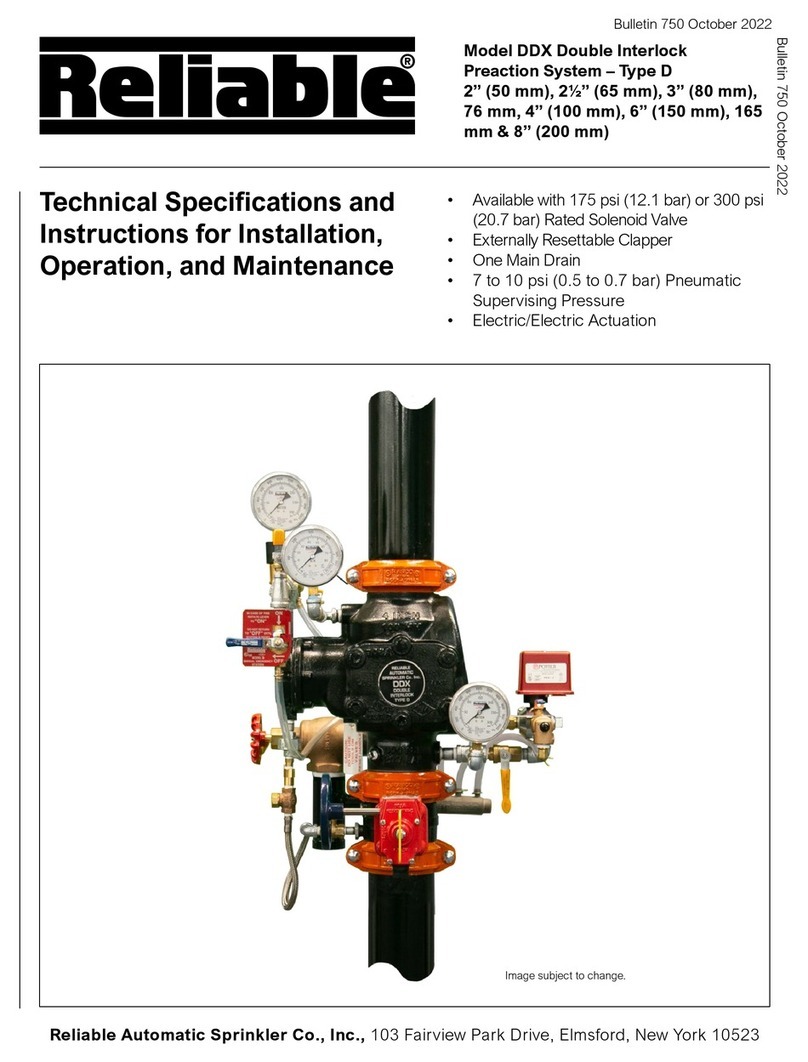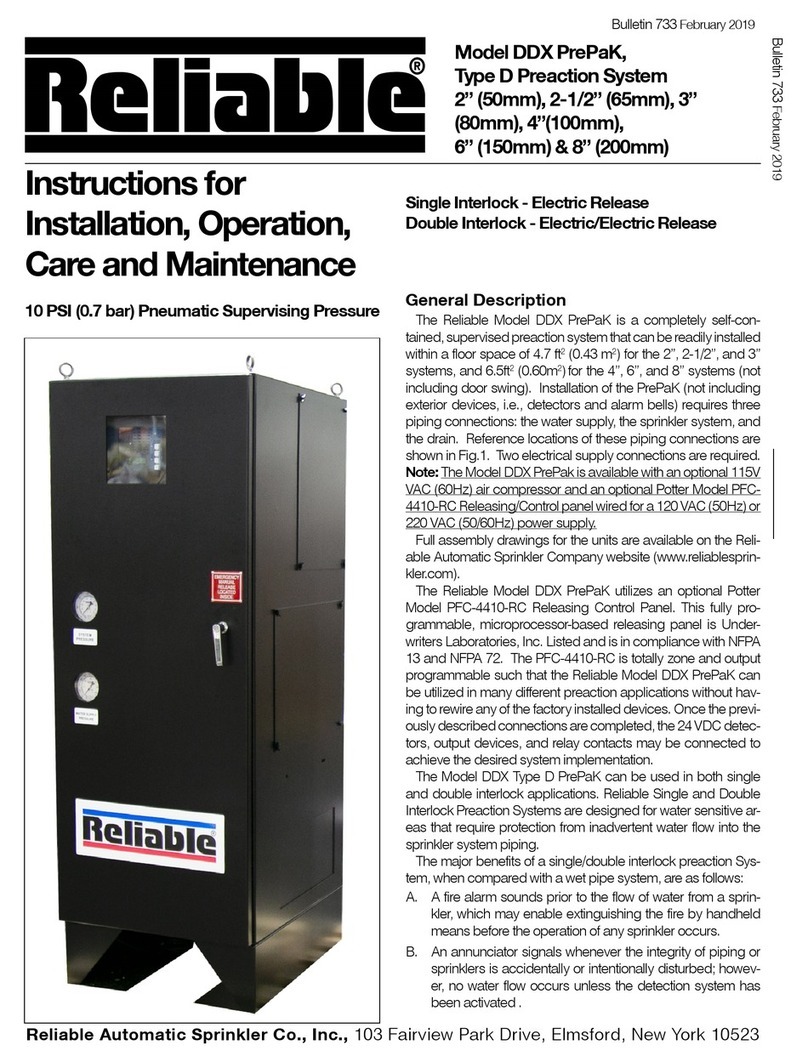
5.
switch.
System Electrical Requirements
All 24 VDC electrical connections in the Reliable Model
DDX-LP PrePak are translated to a water tight terminal box
mounted on the inside of the enclosure. All field wiring con-
nections are made at this terminal box.
A separate power connection is provided for the optional
air compressor.
Note: The air compressor must be connected to a
grounded metallic, permanent wiring system, or an equip-
ment grounding terminal or lead on the product. Power sup-
ply wiring must conform to all required safety codes and be
installed by a qualified person. Check that the supply volt-
age agrees with that listed on compressor nameplate. Also
the wires running from the main electrical supply to the com-
pressor must agree with the values specified in Table C. An
undersized wire is a potential fire hazard and will cause a
drop in line voltage resulting in loss of power causing the
compressor to overheat.
Table C
Amps Volts Length of cord in feet
120v 20 50 100 150 200 250 300 400 500
240v 60 100 200 300 400 500 600 800 1000
0-2 18 18 18 16 16 14 14 12 12
2-3 18 18 16 14 14 12 12 10 10
3-4 18 18 16 14 12 12 10 10 8
4-5 18 18 14 12 12 10 10 8 8
5-6 18 16 14 12 10 10 8 8 8
6-8 18 16 12 10 10 8 6 6 6
8-10 18 14 12 10 8 8 6 6 4
10-12 16 14 10 8 8 6 6 4 4
12-14 16 12 10 8 6 6 6 4 2
14-16 16 12 10 8 6 6 4 4 2
16-18 14 12 8 8 6 4 4 2 2
18-20 14 12 8 6 6 4 4 2 2
The Reliable Model DDX-LP PrePak is available with the
following factory installed electrical devices:
1. A system low air pressure switch, which is used to
monitor sprinkler piping.
2. An alarm pressure switch, which indicates actuation
of the system.
3. An optional low nitrogen pressure switch, which indi-
cates a depleted nitrogen supply.
4. An optional air compressor.
5. A supervised supply side butterfly water control valve.
6. A optional supervised system side butterfly water con-
trol valve.
The factory electrical connections of these devices are
illustrated in Fig. 3.
Maintenance
The Reliable DDX-LP PrePak and associated equipment
shall periodically be given a thorough inspection and test.
NFPA 25, Standard for Inspection, Testing and Maintenance
of Water Based Fire Protection Systems, provides minimum
maintenance requirements. Systems should be tested, op-
erated, cleaned and inspected at least annually, and parts
replaced as required. Periodically open the condensate
drain valve beneath the air tank to drain any condensate ac-
cumulation. Reliable Technical Bulletins 338 and 519 pro-
vide additional information for maintaining the Model DDX-
LP PrePak Deluge Valve.
System Setup (Refer to Figure 2)
1. Close the main valve controlling water supply to the
Model DDX-LP PrePak deluge valve. Also, close the
two ¼” valves supplying air or nitrogen to the system.
2. Close the pushrod chamber supply valve.
3. Open the main drain valve and drain the system.
4. Open all drain valves and vents at low points through-
out the system, closing them when flow of water has
stopped.
5. Open the Manual Emergency Release valve. Note: The
above steps accomplish the relieving of pressure in the
pushrod chamber of the deluge valve.
6. Push in the plunger of ball drip valve to force the ball
from its seat, and drain any water in the alarm line.
7. Push in and rotate the deluge valve’s external reset knob
counter-clockwise (when facing valve) until you hear a
distinct clicking noise, indicating that the clapper has
reset. Note: The reset knob can be rotated only after
pressure in the pushrod chamber is reduced to atmo-
spheric conditions (0 psig).
8. Inspect and replace any portion of the sprinkler system
subjected to fire conditions.
9. Verify that the following valves are in their respective po-
sitions prior to continuing:
Manual Emergency Release - open
Main Drain Valve - open
Alarm Line Valve - open
Alarm Test Valve - closed
Condensate Drain valve - closed
Air/Nitrogen Supply Valves - closed
10. Open pushrod chamber supply valve and allow water
to fill the pushrod chamber. Close the Manual Emer-
gency Release valve after any trapped air has had a
chance to escape from the deluge valve’s pushrod
chamber.
11. Upon seeing this solid flow of water coming out of the
Model LP Dry Pilot Actuator, open the Rapid-Air Fill
Valve thereby rapidly applying compressed air or ni-
trogen into the Model LP Dry Pilot Actuator and the
sprinkler system until the pressure conforms to Table
A levels, as indicated by the system air pressure
gauge. The Model LP Dry Pilot Actuator will eventually
close during this pressurizing process and water will
stop flowing through the drain tube. At this point, the
pressure gauge on the pushrod chamber pressure will
equalize to the available water supply pressure. Once
the actuator is set up correctly, close the Rapid-Air Fill
Valve and open the Regulated Air Shutoff Valve.
Note: For systems using nitrogen as the primary
source, the system may be set up using the nitrogen
source following the steps above. The air compres-
sor, if present, may then be placed into operation as
the backup pneumatic source.






























